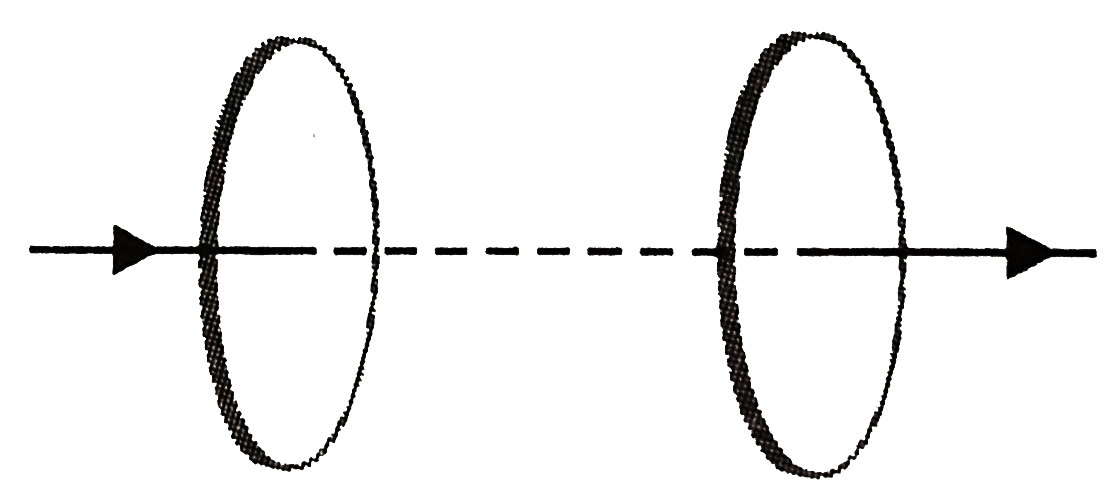(a) Fig shows a capacitor made of two circular plates each of radius 12cm and separated by 5.0mm. The capacitor is being charged by an external source (not shown in the figure). The charging current is constant and equal to 0.15A. Use Ampere's law (modified to include displacement current as given in the text) and the symmetryin the problem to calculate magnetic field between the plates at a point (i) on the axis (ii) 6.5 cm from the axis (iii) 15cm from the axis.
(b) At what distance from the axis is the magnetic field due to displacement current greatest? Obtain the maximum value of the field. 
Here, R=0.12m,I=0.15A
∴ Area of the plate, A=πR2=π×(0.12)2m2
(a) Consider a loop of radius r between the two
circular plates, placed coaxially with them.
Then area of the loop, A'=πr2
By symmetry magnetic field induction →B is
equal in magnitude and is tangentially to the circle
at every point.
In this. only displacement current ID will
cross the loop. Therefore, using Ampere's Maxwell
law, we have
∮→B.→dl=μ0ID
2πrB=μ0×(current passing
through the area A')
=μ0IDπr2πR2 for r<R
=μ0ID forr>R
Thus, B=μ0IDr2R22πr=μ0IDr2πR2....(i) (Ifr<R)
and B=μ0ID2πr....(ii) (If r>R)
(i) On the axis, r=0
Using (i), we get, B=0
(ii) For a point 6.5cm from the axis,
r=6.5cm=6.5×10−2m.
Using (i), we have,
B=4π×10−7×0.15×6.5×10−22π×(12×10−2)2
=1.35×10−7T
(iii) For a point 15 cm from the axis,
r=15cm=0.15m.
Using (ii), we have
B=4π×10−7×0.152π×0.15=2×10−7T
(b) From equation (i) and (ii) we note that B
is maximum if r=R=12cm=0.12m
∴Bmax=μ0ID2πR=4π×10−7×0.152π×0.12
=2.5×10−7T
Related Playlists
- BOOK - PRADEEPCHAPTER - ELECTROMAGNETIC WAVESEXERCISE - (I) Conceptual problems1videos
ELECTROMAGNETIC WAVES
- BOOK - PRADEEPCHAPTER - ELECTROMAGNETIC WAVESEXERCISE - Conceptual problems3videos
ELECTROMAGNETIC WAVES
- BOOK - PRADEEPCHAPTER - ELECTROMAGNETIC WAVESEXERCISE - II Focus multiple choice question5videos
ELECTROMAGNETIC WAVES
- BOOK - PRADEEPCHAPTER - ELECTROMAGNETIC INDUCTION & ALTERNATING CURRENTEXERCISE - Multiple Choice Questions1videos
ELECTROMAGNETIC INDUCTION & ALTERNATING CURRENT
- BOOK - PRADEEPCHAPTER - ELECTRONIC DEVICESEXERCISE - Fill in the Blanks1videos
ELECTRONIC DEVICES
Knowledge Check
- Question 1 - Select One
A capacitor made of two circular plates each of radius 12 cm and separated by 5 mm. The capacitor is being charged by an external source. The charging current is constant and equal to 0.15 A. The capacitance of the parallel plate capacitor is
 A40 pFB45 pFC70 pFD80 pF
A40 pFB45 pFC70 pFD80 pF - Question 1 - Select One
A capacitor made of two circular plates each of radius 12 cm and separated by 5 cm. The capacitor is being charged by an external source. The charging current is constant and equal to 0.15 A. The capacitance of the parallel plate capacitor is
 A40 pFB45 pFC70 pFD80 pF
A40 pFB45 pFC70 pFD80 pF - Question 1 - Select One
A parallel plate capacitor consists of two circular plates each of radius 12cm and separated by 5.0mm. The capacitor is being charge by an external source. The charging current is constant and is equal to 0.15 A. The rate of change of potential difference between the plate will be
A8.173×107Vs−1B7.817×108Vs−1C1.173×109Vc−1D3.781×1010Vs−1
Similar Questions
A parallel plate capacitor made of two circular plates each of radius 10 cm and separated by 4.0mm. The capacitor is being charged by an external source. The charging current is constant and equal to 0.10A. Calculate (i) the capacitance (ii) the rate of change of potential difference between the plates (iii) the displacement current.
View SolutionFig. shows a capacitor made of two circular plates each of radius 12 cm and separated by 5.0mm. The capacitor is being charged by an external source (not shown in the figure). The charging current is constant and equal to 0.15A.
(a) Calculate the capacitance and the rate of change of potential difference between the plates.
(b) Obtain the displacement current across the plates.
(c) Is Kirchhoff's first rule valid at each plate of the capacitor ? Explain.
 View Solution
View SolutionFig. shows a capacitor made of two circular plates each of radius 12 cm and separated by 5.0mm. The capacitor is being charged by an external source (not shown in the figure). The charging current is constant and equal to 0.15A.
(a) Calculate the capacitance and the rate of change of potential difference between the plates.
(b) Obtain the displacement current across the plates.
(c) Is Kirchhoff's first rule valid at each plate of the capacitor ? Explain.
 View Solution
View SolutionFigure 8.01 shows a capacitor made of two circular plates each of radius 12 cm, and separated by 5.0 cm. The capacitor is being charged by an external source (not shown in the figure). The charging current is constant and equal to 0.15 A.
(a) Calculate the capacitance and the rate of charge of potential difference between the plates.
(b) Obtain the displacement current across the plates.
(c) Is Kirchhoff.s first rule (junction rule) valid at each plate of the capacitor? Explain.
 View Solution
View SolutionFigure shows a capacitor made of two circular plates each of radius 12cm, and separated by 5.0cm. the capacitor is being charged by an external source (not shown in the figure). The charging current is constant and equal to 0.15A
(a) Calcuate the capacitance and the rate of change of potential difference between the plates
(b) Obtain the displacement current across the plates
(c) Is kirchhoff's first rule(junction rule) vaild at each plate of the capacitor ? Explain.
 .View Solution
.View SolutionFigure shows a capacitor made of two circular plates each of radius 12cm, and separated by 5.0cm. the capacitor is being charged by an external source (not shown in the figure). The charging current is constant and equal to 0.15A
(a) Calcuate the capacitance and the rate of change of potential difference between the plates
(b) Obtain the displacement current across the plates
(c) Is kirchhoff's first rule(junction rule) vaild at each plate of the capacitor ? Explain.
 .View Solution
.View SolutionA capacitor consists of two circular plates each of radius 8.0 cm and separated by 3.0 mm. The capacitor is being charged by an external battery. The charging current is constant and is equal to 0.3 A. Calculate (i) capacitance of capacitor, (ii) the rate of change of potential difference across the plates of capacitor and (iii) the displacement current.
View Solution

